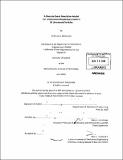| dc.contributor.advisor | Mary L. Cummings. | en_US |
| dc.contributor.author | McDonald, Anthony D. (Anthony Douglas) | en_US |
| dc.contributor.other | Massachusetts Institute of Technology. Dept. of Mechanical Engineering. | en_US |
| dc.date.accessioned | 2010-11-08T17:50:17Z | |
| dc.date.available | 2010-11-08T17:50:17Z | |
| dc.date.copyright | 2010 | en_US |
| dc.date.issued | 2010 | en_US |
| dc.identifier.uri | http://hdl.handle.net/1721.1/59947 | |
| dc.description | Thesis (S.B.)--Massachusetts Institute of Technology, Dept. of Mechanical Engineering, 2010. | en_US |
| dc.description | Cataloged from PDF version of thesis. | en_US |
| dc.description | Includes bibliographical references (p. 33). | en_US |
| dc.description.abstract | Most current Unmanned Vehicle (UV) systems consist of teams of operators controlling a single UV. Technological advances will likely lead to the inversion of this ratio, and automation of low level tasking. These advances will also lead to a growth in UV use in large-scale applications such as urban search and rescue, which will require the use of both teams of operators and teams of UVs. This growth will in turn require research and development in the area of team supervisory control of multiple UVs. Human-in-the- loop experimentation is often used during this research but can be time consuming and expensive. The time and cost of experimentation can often be drastically reduced by using predictive models. However there is a lack of such models in the area of multiple-operator supervisory control of multiple- UVs. This problem is addressed in this thesis through the following method: First, current predictive models of human supervisory control of UVs are analyzed, and attributes of systems related to this modeling space are identified. Second, a queuing-based multiple-operator multiple-vehicle discrete event simulation model (MO-MUVDES) is developed which captures these attributes, including the ability to predict performance in situations with low observable exogenous event arrivals. MO-MUVDES also incorporates traditional system variables such as level of vehicle autonomy, vehicle and operator team structure, and operator switching strategy. The accuracy and robustness of the MO-MUVDES model were measured by a two-stage validation process using data from a human-in-the-loop supervisory control experiment, and a Monte Carlo simulation. The first stage of the validation process used data from the experiment as input for the MOMUVDES model which was then used to generate predictions of operator performance. In the second stage of validation, a sensitivity analysis was performed on the MO-MUVDES model. This validation process achieved confidence in the model's ability to predict operator performance and a measurement of the robustness of the model under varying input conditions. Additionally, the process indicated that discrete event simulation is an effective technique for modeling team supervisory control of UVs in a situation where exogenous event arrivals are not clearly observable. As a result, the MO-MUVDES model could be used to reduce development time for systems within its modeled space. | en_US |
| dc.description.statementofresponsibility | by Anthony D. McDonald. | en_US |
| dc.format.extent | 37 p. | en_US |
| dc.language.iso | eng | en_US |
| dc.publisher | Massachusetts Institute of Technology | en_US |
| dc.rights | M.I.T. theses are protected by
copyright. They may be viewed from this source for any purpose, but
reproduction or distribution in any format is prohibited without written
permission. See provided URL for inquiries about permission. | en_US |
| dc.rights.uri | http://dspace.mit.edu/handle/1721.1/7582 | en_US |
| dc.subject | Mechanical Engineering. | en_US |
| dc.title | A discrete event simulation model for unstructured supervisory control of unmanned vehicles | en_US |
| dc.type | Thesis | en_US |
| dc.description.degree | S.B. | en_US |
| dc.contributor.department | Massachusetts Institute of Technology. Department of Mechanical Engineering | |
| dc.identifier.oclc | 676921452 | en_US |
